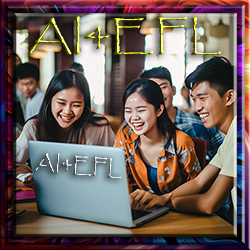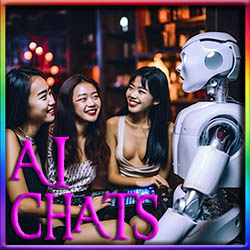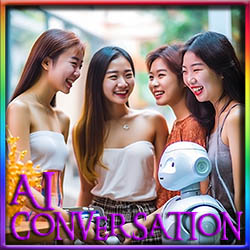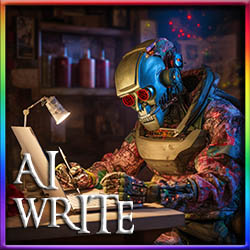
Social Language Games for
EFL Students
Improving English Fluency with ChatGPT
Welcome to the wonderful world of using ChatGPT with voice as a means to improve spoken English through social language games. I created an early version of this handout for my university students in English Oral Training courses. However, the beast grew by more than a bit so this current version is for teachers as well as students. I hope you find it helpful.
My original impetus was to create a means for my students to practice their spoken English outside of class in a way that both simulated conversation with native English speakers (something students in Taiwan don’t always have ready free access to) and offered them quality advice for improvement (presuming they use the appropriate prompting techniques and are themselves aggressive about onboarding such suggestions).
I am a big believer in using games as tools for language learning and over the past three-and-a-half decades have referenced Patricia Mugglestone’s “curiosity motive” in more papers, presentations, and workshops than I can count. The difference now is that students have access to an AI study buddy that can act both as conversation partner and tutor in an easily accessible and affordable manner (free is a great price).
Before we get too deep in the weeds, I do want to point out that while this manual refers specifically to ChatGPT, these social language learning games can be used with pretty much any chatbot based upon a Large Language Model. My students use ChatGPT as the free version at the time of this writing is still quite robust. As much as possible, I prefer to use free or free-ish resources for my students as I am not comfortable with the inflated pricing of books for academic purposes and would rather keep student costs down as much as possible. Others may feel differently and that’s their water to carry.
In the realm of global communication, proficiency in English stands as a pivotal skill, serving as a gateway to academic, professional, and personal growth. Yet, for English as a Foreign Language (EFL) students residing in non-English-speaking countries, the journey to fluency is fraught with obstacles. Traditional language learning approaches often emphasize grammatical rules and written exercises, which, while foundational, do not fully address the nuances of spoken language and real-life conversation. The lack of exposure to native speakers and the opportunities for immersive interaction further compound these challenges, leaving students well-versed in the theoretical aspects of English but hesitant and unconfident in its practical use.
Enter the innovative solution of social language games guided by ChatGPT with voice. This approach marries the advancements in artificial intelligence with the intrinsic human love for play, creating a dynamic learning environment that transcends conventional boundaries. Through engaging in social language games, learners are not merely passive recipients of information but active participants in their educational journey. ChatGPT, equipped with voice interaction, serves as both a guide and a companion, offering real-time feedback, diverse conversational scenarios, and a level of interactivity that books and traditional learning modules cannot match.
The thesis of this exploration posits that ChatGPT-guided social language games, with their voice interaction capability, can revolutionize English language learning for EFL students. By leveraging the natural human curiosity through engaging and interactive game mechanics, these games tap into the motivational core of learners, driving them towards sustained engagement and deeper learning. The gamification elements inherent in this approach—notably, the use of points, levels, and rewards—mirror the motivational strategies used in video games and educational apps, promoting a sense of achievement and progress. Furthermore, the emphasis on spoken interaction addresses one of the most significant gaps in traditional EFL education: the opportunity for conversational practice. Through simulated dialogues, nuanced language use, and exposure to a variety of accents and idiomatic expressions, students can gain the confidence and competence needed to navigate the complexities of English conversation in real-world settings.
This introduction sets the stage for a comprehensive examination of how ChatGPT-guided social language games can transform the landscape of EFL education, highlighting the interplay between technology, motivation, and linguistic proficiency. Through this lens, we will delve into the multifaceted benefits of this innovative approach, underscoring its potential to not only enhance language learning outcomes but also to foster a global community of confident, articulate English speakers.
Engaging the Curiosity Motive
Thinkers from Mugglestone to Chomsky to Jung to many others have discussed the curiosity motive, a fundamental human impulse, drives individuals to explore, discover, and learn, propelling them beyond the confines of familiar knowledge into the realms of the unknown and the novel. In educational psychology, curiosity is recognized not merely as a trait but as a critical mechanism for learning, acting as the intellectual appetite that motivates learners to seek new information, understand complex phenomena, and solve problems. The importance of this motive in learning cannot be overstated; it is the spark that ignites a learner’s engagement, transforms passive absorption into active investigation, and, most importantly, sustains interest and motivation over time. By fostering curiosity, educators can facilitate deeper learning, encourage exploration, and promote a lifelong love for learning.
ChatGPT-guided social language games uniquely cater to the curiosity motive through their design and execution. By leveraging the capabilities of ChatGPT, these games introduce learners to unexpected outcomes and scenarios, a wide array of topics, and a dynamic form of interactive learning. Each interaction with ChatGPT can lead to new conversational paths, unforeseen challenges, and the discovery of novel language constructs, mirroring the unpredictable nature of real-life conversations. This unpredictability and novelty serve as key elements in stimulating curiosity, as learners are continually presented with opportunities to explore language in ways that traditional textbooks and scripted lessons cannot offer. Furthermore, the adaptive nature of ChatGPT allows it to introduce content that aligns with the learners’ interests and proficiency levels, ensuring that the learning experience remains engaging, relevant, and challenging enough to provoke inquiry and exploration.
Several case studies and theoretical frameworks underscore the efficacy of curiosity-driven learning outcomes, particularly in the context of language acquisition. The Information Gap Theory, for example, posits that curiosity arises when there is a perceived gap between what one knows and what one wants to know. This gap creates a cognitive itch that learners are motivated to scratch, leading them to seek out new information and experiences. In the case of ChatGPT-guided games, this gap can be manifested through challenging questions, prompts for creative language use, or scenarios that require learners to apply their language skills in novel ways. Theories such as Constructivist Learning Theory also support the role of curiosity in learning, emphasizing the importance of active exploration and the construction of knowledge through real-world experiences. By simulating these experiences, ChatGPT-guided games provide a fertile ground for curiosity to flourish, enabling learners to build their language skills through exploration, experimentation, and discovery.
I have found that the engagement of the curiosity motive through ChatGPT-guided social language games represents a paradigm shift in language learning. By aligning with the natural human propensity for curiosity, these games not only enhance the learning experience but also foster a deeper, more intrinsic motivation for language acquisition. Through the stimulation of curiosity, learners are encouraged to embark on a journey of continuous exploration and growth, laying the foundation for lifelong learning and proficiency in the English language.
Increased Practice in Conversation
One of the paramount hurdles in mastering a foreign language, particularly for students in non-English-speaking countries, is the scarcity of opportunities to practice speaking with native speakers. Engaging in conversation with native speakers exposes learners to the nuances of pronunciation, idiomatic expressions, and cultural contexts that textbooks or classroom settings might overlook. This gap in real-world practice often results in a significant disparity between a student’s ability to understand written language and their proficiency in spoken communication, making the path to fluency a challenging endeavor.
In this landscape, ChatGPT with voice emerges as a pivotal tool, bridging the gap between traditional language learning methodologies and the dynamic requirements of conversational fluency. By simulating real-life interactions through voice-based conversations, ChatGPT allows learners to immerse themselves in an environment where they can practice speaking and listening in a natural and interactive manner. This AI-driven approach not only familiarizes students with the rhythm and flow of conversational English but also adapts to their learning pace, offering personalized feedback and suggestions to improve their language skills. The voice interaction feature of ChatGPT is particularly effective in enhancing pronunciation and listening comprehension, as learners are required to articulate their thoughts clearly and understand spoken responses, thereby mirroring the intricacies of real-life conversations.
The importance of regular, varied conversational practice in language acquisition cannot be understated. Language proficiency is not solely the accumulation of vocabulary and grammar rules but also the ability to deploy these elements spontaneously and appropriately in diverse contexts. Regular interaction with ChatGPT with voice enables learners to encounter a wide array of conversational scenarios, from formal discussions to casual chats, each presenting its unique set of linguistic challenges and learning opportunities. This variety ensures that learners are not only exposed to different aspects of the language but are also equipped to handle various communication situations, thereby fostering a well-rounded language competence.
Furthermore, the adaptability of ChatGPT with voice supports the development of fluency by gradually increasing the complexity of conversations based on the learner’s proficiency level. This scaffolding approach ensures that learners are constantly challenged just beyond their current capabilities, promoting language development in a supportive and effective manner. The interactive nature of ChatGPT also encourages learners to take risks in their language use, experiment with new expressions, and learn from their mistakes in a low-stakes environment, which is crucial for building confidence and proficiency in language use.
In conclusion, the integration of ChatGPT with voice in language learning offers a transformative solution to the challenges of conversational practice faced by EFL students. By providing an accessible platform for immersive and varied conversational practice, ChatGPT with voice not only facilitates the development of speaking and listening skills but also significantly contributes to the learner’s journey towards fluency. This innovative approach, leveraging the capabilities of artificial intelligence, holds the potential to redefine language learning, making the acquisition of conversational proficiency an engaging, effective, and attainable goal for learners worldwide.
Note and Tips
I started this project wanting my English as a Foreign Language students at university in Taiwan to use ChatGPT’s voice mode more to practice their spoken English. So I set out to discover social language games they could play with the AI (by themselves or with 1-3 friends) that would encourage them to speak using English more and more. These could be conversational social style games or straight up language grammar or spelling games (like Hangman) but I insisted the games must be engaging and FUN in order to capture the “curiosity motive” while providing students with ample opportunity for quality language practice and feedback.
Turn on the option for using voice and go for it!
While all of the included games here should work, as with most AI platforms currently, one may need to tweak the prompting. If you fid a particular chat session or bot is not reading the prompt correctly, copying the entire game entry should work fine.
While it’s not necessary in all cases, I do find adjusting the prompts in a way to ensure the AI does not dominate the conversation and so that the AI encourages the student to speak more. It is also helpful to ask the AI to hold off on correction or feedback until the end of the conversation. So, I strongly suggest appending the following to all prompts in this project:
“Keep your responses brief and encourage me to speak more. Do not interrupt or correct me until the end. When I say I wish to stop the conversation, offer me corrections and constructive criticism so I can improve.”
Seriously, this addition is extremely helpful for students of English as a Foreign Language (and most other folks too).
So, go for it. Yes, there are 101 games listed here. Some are obviously much better than others but I don’t know which you will enjoy more than others. So experiment . . . fool around . . . and find out. Most of all, HAVE FUN!
Here is the first game I devised for the collection. Yes, it is more of a listening comprehension activity but students have had a lot of fun with it!
Story Time Quiz Battle
Objective: Enhance listening comprehension and recall abilities by answering questions about a story told by ChatGPT. This game combines storytelling with a competitive quiz format.
Players: 2-3 (Player A, Player B, and optionally Player C)
How to Play:
- ChatGPT tells a 400-word story based on a prompt provided by the players. The story can be about anything, from a whimsical adventure to a historical event, depending on the players’ preferences.
- After the story is told, players take turns answering questions posed by ChatGPT about the story’s details, characters, plot points, or moral lessons.
- If a player answers a question correctly, they earn a point. If they answer incorrectly, the question passes to the next player, who has a chance to steal the point.
- The game continues with players taking alternating turns to answer questions. The first player to reach five (or ten, for a longer game) points wins.
- This game tests and improves players’ attention to detail, memory, and comprehension skills. It encourages active listening and engagement with the story.
Prompt: “Tell me a 400-word [fantasy] story about [a mysterious enchanted forest and its hidden secrets]. Then, let’s play a game. I am Player A and my two friends are Players B and C. We will take alternating turns, and you will ask us questions about the story. If a player answers correctly, they get a point. If they answer wrong, then the other players get a chance to answer and steal the point. The first person to get ten points wins.”
HERE’S THE FILE,
TRY SOME GAMES!
wakingdreams.org/wp-content/uploads/2024/04/ChatGPT-EFL-voicegames-bdp3.pdf
Yes, 101 Social Language Games!
Additional Advantages of Using ChatGPT with Voice for Language Learning
Beyond the direct linguistic benefits, the integration of ChatGPT with voice into the language learning ecosystem brings forth several additional advantages that significantly enrich the learning experience. Among these, the accessibility and flexibility offered by this technology stand out, dismantling traditional barriers to language education. In today’s fast-paced world, learners often juggle multiple responsibilities, making it challenging to adhere to fixed schedules or locations for language study. ChatGPT with voice transcends these constraints, allowing learners to engage with language learning materials anytime and anywhere. Whether during a morning commute, on a lunch break, or in the comfort of one’s home, the only requirement is a digital device and internet access. This ubiquity ensures that language learning can seamlessly integrate into daily routines, making consistent practice more achievable and less of a logistical challenge.
Customization is another cornerstone of ChatGPT with voice, tailoring the language learning journey to the unique needs and goals of each learner. Traditional classroom settings and even many online courses follow a one-size-fits-all curriculum, which may not align with every learner’s interests, proficiency level, or learning pace. In contrast, ChatGPT with voice can dynamically adjust the difficulty level, topics, and learning strategies based on the learner’s interactions and feedback. This personalized approach ensures that the content remains challenging yet achievable, fostering a positive learning experience and maximizing educational outcomes. Customization also means that learners can focus on areas of particular interest or difficulty, whether that’s business English, conversational slang, or academic writing, thus making the learning experience more relevant and engaging.
Furthermore, ChatGPT with voice offers the potential to integrate cultural learning alongside language skills, providing a more holistic educational experience. Language and culture are inextricably linked, with cultural nuances deeply embedded in idiomatic expressions, humor, and social norms. Understanding these cultural elements is crucial for achieving true linguistic fluency and for navigating social interactions in diverse contexts. ChatGPT, with its extensive database and conversational capabilities, can introduce learners to cultural concepts, customs, and histories relevant to the English-speaking world. This cultural immersion can enhance comprehension, improve communicative competence, and foster a deeper appreciation for the diversity within English-speaking communities.
The combination of accessibility, customization, and cultural integration underscores the transformative potential of ChatGPT with voice in language learning. By providing a flexible, personalized, and comprehensive learning experience, this technology not only addresses the practical challenges of acquiring a new language but also enriches the educational journey. Learners are equipped not just with linguistic skills but with the cultural understanding and adaptive capabilities needed to thrive in a globalized world. As such, ChatGPT with voice represents not merely a tool for language learning but a gateway to broader horizons, inviting learners to explore, connect, and grow in unprecedented ways.
Social Language Games and ChatGPT
In the exploration of the multifaceted benefits of utilizing ChatGPT-guided social language games, particularly for English as a Foreign Language (EFL) students, we have traversed through a rich landscape of educational innovation. The journey began with an understanding of how these interactive games captivate the curiosity motive, a fundamental catalyst in the learning process. Through unexpected outcomes, varied topics, and the dynamic nature of interactive learning, ChatGPT-guided games awaken the innate desire to explore and understand, transforming the language learning experience from a task to be endured into an adventure to be embarked upon.
Further delving into the realm of gamification, we uncovered the parallel benefits that ChatGPT-guided games share with this powerful educational strategy. By incorporating elements such as points, levels, and rewards, these games not only make learning more engaging but also tap into the deeper motivational structures that drive human behavior. The comparative analysis revealed how traditional gamification techniques, when blended with the adaptive and responsive capabilities of ChatGPT, elevate the learning experience, fostering a sense of achievement and progress while simultaneously providing a safe space for learners to experiment and learn from their mistakes.
The conversation then shifted to the paramount importance of regular, varied conversational practice in achieving language fluency. In environments where access to native speakers is limited, ChatGPT with voice stands as a beacon of opportunity, offering learners the chance to immerse themselves in realistic conversational scenarios. This practice, mimicking real-life interactions, is crucial for the development of speaking and listening skills, allowing learners to navigate the nuances of language with greater confidence and competence.
Across these discussions, additional advantages of using ChatGPT for language learning emerged, highlighting the unparalleled accessibility, flexibility, and customization offered by this technology. Learners are no longer bound by geographical or temporal constraints, empowered to pursue their language learning goals on their own terms. Moreover, the potential for integrating cultural learning into language practice presents an opportunity to enrich the educational experience, fostering not only linguistic proficiency but also a deeper understanding and appreciation of the cultural diversity within the English-speaking world.
Drawing upon case studies and success stories, we have seen the tangible impact of ChatGPT-guided social language games in various educational settings. From universities to language learning apps, the positive feedback from students and educators alike underscores the effectiveness of these methods in enhancing language skills. These narratives serve as a testament to the transformative potential of ChatGPT-guided games in revolutionizing language education, bridging the gap between technology and pedagogy to create more engaging, effective, and enjoyable learning experiences.
In conclusion, the journey through the benefits of ChatGPT-guided social language games for EFL students unveils a horizon of possibilities where technology enhances the human capacity for learning. By engaging curiosity, leveraging the benefits of gamification, and providing ample opportunities for conversational practice, this innovative approach not only addresses the challenges inherent in language learning but also opens new pathways for exploration, growth, and connection in our increasingly globalized world. As we look to the future, it is clear that the integration of artificial intelligence in education will continue to play a pivotal role in shaping the landscape of language learning, offering learners around the globe the tools they need to succeed in their linguistic endeavors.
You Can Learn More
If you would like to learn more about using hypnosis techniques, consult our Core Skills program and other products found in our online store at http://briandavidphillips.net/store (you may wish to check out our package programs for even more value).
Our ErosPsyMagick+ program at http://briandavidphillips.net/erospsymagickplus is of particular interest as it has everything rolled into one comprehensive package . . . core skills, metaphysical magickal psychic, and eroticatrance ecstatic states.
If you’re in Taiwan and interested in hypnosis, check the services page linked to in the top left sidebar. Not in Taipei? Check the store for recordings in the same menu area as well as links to lots and lots of info and goodies. Of course, browsing this site will bring you to a digital ton of positive resources on a wide variety of topics as well.
Live Trance and Prosper,
Brian David Phillips
Trance Wizard
www.BrianDavidPhillips.net/blog
Tarot Decks and More
https://www.makeplayingcards.com/sell/wakingdreams



















